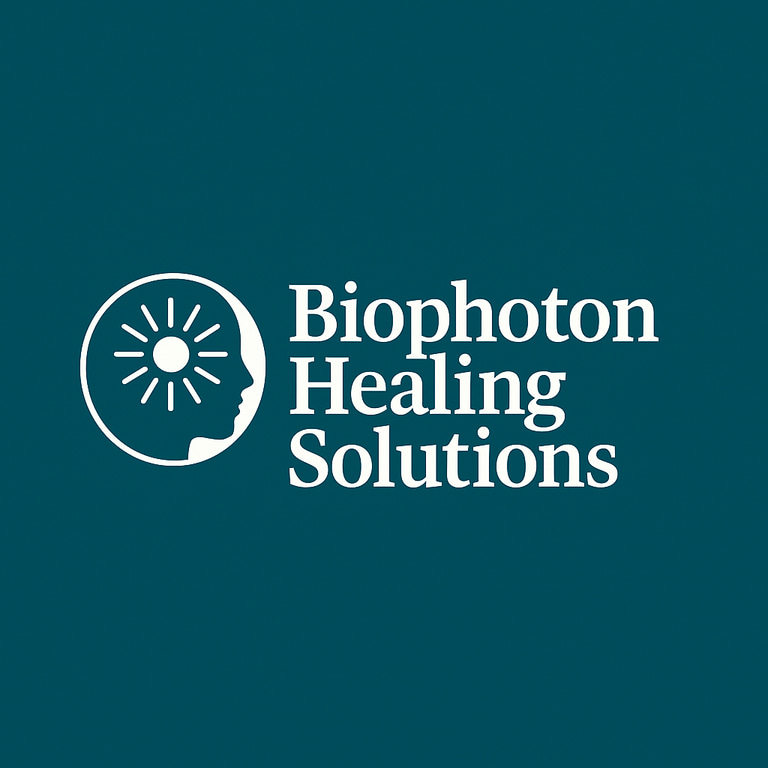How Are BioPhotons Generated Naturally and Artificially?
Natural Generation: Biophotons are generated as a natural byproduct of various biochemical reactions, chiefly those involving oxygen. The currently accepted mechanism is that reactive oxygen species (ROS) – chemically reactive molecules produced during metabolism – create excited molecular intermediates that emit photons when returning to their ground state.
For example, in our mitochondria (the cell’s power plants), the normal process of respiration can leak small amounts of superoxide (O_2^•−). Through a cascade, superoxide and other ROS lead to formation of singlet oxygen (^1O_2) and excited carbonyl compounds. When an excited singlet oxygen or carbonyl relaxes, it releases a photon. These emissions are in specific wavelength bands – e.g. excited carbonyls emit blue-green light (around 350–550 nm), while singlet oxygen can emit red/NIR light (~634, 703, 1270 nm).
Thus, cellular respiration and oxidative reactions “light up” the cell in ultra-dim fashion. Lipid peroxidation (oxidative damage to fats), enzymatic reactions in peroxisomes, and even oxidative enzyme reactions (like by peroxidases or lipoxygenases) can all produce faint luminescence. Notably, higher oxidative stress leads to stronger biophoton emission – under normal conditions a tissue might emit tens of photons per second per cm^2, but under stress this can rise to hundreds per second. This aligns with experiments showing that removing antioxidants (which let ROS accumulate) causes tissues to emit more biophotons, and conversely adding ROS-generating agents increases the light output. In essence, any process that creates excited molecular states (especially via ROS) will naturally generate biophotons.
Figure: Mechanism of biophoton generation via mitochondrial metabolism. Reactive oxygen species (ROS) produced in the mitochondria (e.g. superoxide, singlet oxygen) react with biomolecules to form excited states (such as excited carbonyl groups). When these excited molecules relax to ground state, they emit photons. This ultra-weak light spans UV to visible wavelengths and increases under oxidative stress.
Beyond ROS chemistry, other natural sources of UPE include delayed luminescence – after organisms are exposed to sunlight or other illumination, their tissues can re-emit photons for some time as the high-energy states slowly dissipate. (This is akin to a phosphorescent afterglow and was sometimes conflated with true metabolic UPE in early studies.) Living systems are essentially in a perpetual state of low-level chemiluminescence due to metabolic reactions.
Artificial Generation: Interestingly, humans have begun devising ways to generate or harness biophoton-like emissions for research and therapy. In the laboratory, one can artificially trigger biophoton emission by chemical means – for instance, adding certain oxidizing chemicals to cells to produce bursts of ROS, or using substrates that chemiluminesce.
Researchers have used mirrors and nanoparticles to amplify or redirect naturally emitted photons (as in one study where adding silver nanoparticles boosted the UPE from neural stem cells). However, when it comes to biophoton therapy, the term usually refers to devices that create fields or light emissions intended to mimic or stimulate the body’s own biophotonic activity. One common approach is using photobiomodulation – low-level laser or LED devices that emit red to near-infrared light. These artificial light sources aren’t “biophotons” per se (they’re external), but they penetrate tissues and boost cellular metabolism in a similar way. Red/infrared photons are absorbed in mitochondria and can prompt increased production of ATP, ROS, nitric oxide, etc., which then trigger cellular proliferation and signaling cascadespubmed.ncbi.nlm.nih.gov.
In other words, shining the right kind of light on cells can artificially ramp up the same pathways that lead to biophoton emission (and indeed, low-level light therapy can cause a transient increase in a cell’s own ultra-weak emissions due to stimulated metabolism).
Another category is specialized “biophoton generators” or chambers. These are devices explicitly designed to emit an ultra-weak electromagnetic field or light in the biophoton range. For example, Tesla BioHealing™ has developed cylindrical Biophoton Generators that supposedly radiate a “life force energy” field to stimulate cells. According to their description, the device is non-electric and uses natural elements to generate a continuous biophoton field around the body. The company’s patent literature mentions combining far-infrared (FIR) emissions and so-called scalar waves to produce a therapeutic energy field. FIR is simply heat radiation, known to improve blood circulation and tissue healing, while “scalar waves” are a more speculative concept in this context. The key idea is that these devices broadcast a subtle energy field analogous to the body’s own biophotonic fieldemmind.net. Indeed, a recent press release describes the Tesla Biophoton Generator as emitting “ultra-high biophotons” that support cellular repair and regenerationpr.com.
Other artificial means include so-called biophoton chambers or even biophoton-infused water, which involve exposing water or materials to concentrated light fields with the hope of storing “biophoton energy” for later use.
In summary, natural biophotons are generated by normal cellular chemistry – primarily oxidative metabolism producing excited molecules that emit faint light.
Artificial generation can involve either duplicating those chemical processes in vitro, or using technology (like low-level lasers, LEDs, infrared emitters, or specialized “quantum” devices) to create a field of photons that interact with the body. These methodologies aim to stimulate the body’s cells in a manner similar to natural biophoton signals, and form the basis of emerging biophoton therapeutic techniques.
